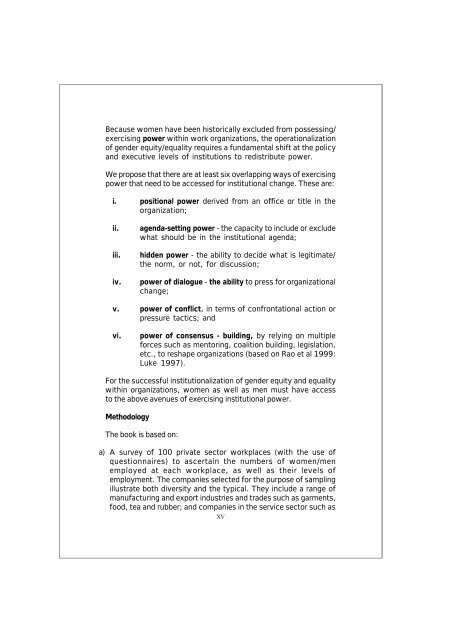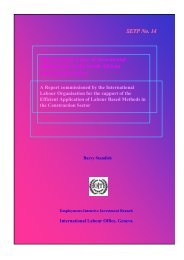Beyond Glass Ceilings and Brick Walls - International Labour ...
Beyond Glass Ceilings and Brick Walls - International Labour ...
Beyond Glass Ceilings and Brick Walls - International Labour ...
You also want an ePaper? Increase the reach of your titles
YUMPU automatically turns print PDFs into web optimized ePapers that Google loves.
Because women have been historically excluded from possessing/<br />
exercising power within work organizations, the operationalization<br />
of gender equity/equality requires a fundamental shift at the policy<br />
<strong>and</strong> executive levels of institutions to redistribute power.<br />
We propose that there are at least six overlapping ways of exercising<br />
power that need to be accessed for institutional change. These are:<br />
i. positional power derived from an office or title in the<br />
organization;<br />
ii.<br />
iii.<br />
iv.<br />
agenda-setting power - the capacity to include or exclude<br />
what should be in the institutional agenda;<br />
hidden power - the ability to decide what is legitimate/<br />
the norm, or not, for discussion;<br />
power of dialogue - the ability to press for organizational<br />
change;<br />
v. power of conflict, in terms of confrontational action or<br />
pressure tactics; <strong>and</strong><br />
vi.<br />
power of consensus - building, by relying on multiple<br />
forces such as mentoring, coalition building, legislation,<br />
etc., to reshape organizations (based on Rao et al 1999:<br />
Luke 1997).<br />
For the successful institutionalization of gender equity <strong>and</strong> equality<br />
within organizations, women as well as men must have access<br />
to the above avenues of exercising institutional power.<br />
Methodology<br />
The book is based on:<br />
a) A survey of 100 private sector workplaces (with the use of<br />
questionnaires) to ascertain the numbers of women/men<br />
employed at each workplace, as well as their levels of<br />
employment. The companies selected for the purpose of sampling<br />
illustrate both diversity <strong>and</strong> the typical. They include a range of<br />
manufacturing <strong>and</strong> export industries <strong>and</strong> trades such as garments,<br />
food, tea <strong>and</strong> rubber; <strong>and</strong> companies in the service sector such as<br />
XV
















